2. 哈尔滨工业大学 化工与化学学院,哈尔滨 150001
2. School of Chemistry and Chemical Engineering, Harbin Institute of Technology, Harbin 150001, China
根据中国建筑节能协会在上海发布的《中国建筑能耗研究报告(2017年)》,房屋建筑在全寿命周期中消费了全国40%~50%的能源。可见,建筑节能已经成为现代社会亟待解决的关键问题。电致变色是对材料施加不同的电压,使材料的价态及组分发生可逆变化,进而引起材料光学属性,如吸收率、反射率、透过率发生可逆改变的现象,如图 1所示。1969年,Deb[1]首先演示了以氧化钨(WO3)为变色层的电致变色器件。1984年Lampert[2]和Granqvist[3]首先提出了智能窗的概念,他们认为将电致变色材料应用于汽车、飞机、建筑等采光系统中,通过调节电压动态调节入射光强度,可以制成节省空调、照明用电能耗的智能窗。目前,国际上有SAGE Electrochromics Inc.[4]和View Inc.[5]两家具有一定产业化能力的电致变色智能窗生产公司,国内浙江上方电子装备有限公司[6]也具备一定的电致变色研发生产能力。1999年,德国Stadt Sparkasse储蓄银行的外墙玻璃首次采用电致变色技术;2004年,英国伦敦的瑞士再保险大厦也使用了电致变色的幕墙玻璃;2005年法拉利Superamerica跑车将其应用于挡风玻璃和顶棚玻璃[7];2008年7月,波音787客机采用电致变色玻璃替代了机械式舷窗遮阳板。
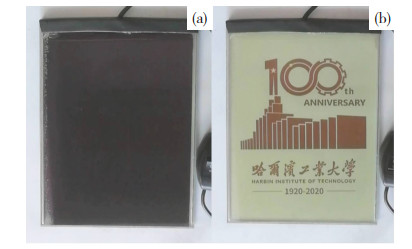
|
图 1 电致变色器件在着色态(a)和褪色态(b)的照片 Fig.1 Images of ECD in colored (a) and bleached (b) states |
虽然对电致变色技术的研究已有半个世纪,但目前仍存在很多问题,如响应速度较慢, 颜色变化单一, 循环寿命短, 成本高等, 限制了其大规模商业化的应用。本文将从全固态电致变色器件的结构特点出发, 总结近期相关研究进展,并展望未来电致变色器件的发展方向。
1 电致变色器件结构传统电致变色器件通常由5层薄膜组成,包括两层透明电极、电致变色层、离子存储层和电解质层[8]。器件中常用的电解质主要有3类:液态、凝胶(又称准固态)和固态电解质,前两者通常具有很高的离子电导率,因此响应速度较快,但液态和凝胶电解质容易泄露和产生气泡,封装比较困难,且耐候性较差,长期光照条件下,对寿命也会产生影响[9],器件结构通常如图 2(a)所示。固态电解质离子电导率较低,通常在10-6S/cm左右,但仍可满足电致变色需求。由固态电解质组装而成的电致变色器件称为全固态电致变色器件,具有性能稳定、易加工、可连续生产、衰退小的优点,而且可以实现在单一基底上逐层制备各层薄膜,如图 2(b)所示,是满足电致变色未来应用的最佳选择。全固态电致变色器件通常采用物理气相沉积的方法制备,最常用的有磁控溅射法和电子束或电阻蒸发镀膜法。
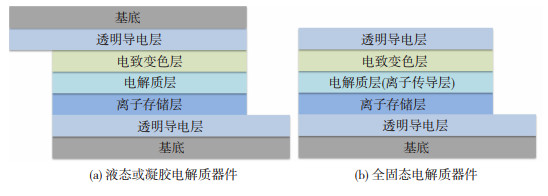
|
图 2 电致变色器件结构示意图 Fig.2 Typical ECD structures: (a) ECD with liquid or gel electrolyte; (b) ECD with solid electrolyte |
电致变色层是目前研究最广泛的电致变色材料,是电致变色器件中的主要功能层,主要承担变色作用。具有电致变色性质的材料有很多,见图 3,但全固态器件中的电致变色层通常需要具有较大的光学调制幅度、较快的响应速度、较高的着色效率和稳定的循环性能。因此,全固态器件通常采用综合性能最好的WO3作为电致变色层,WO3为阴极着色电致变色材料,当对其施加负电压时,离子和电子被注入WO3层中,发生还原反应,变为深蓝色;当施加正电压时,离子和电子脱出变回WO3,如式(1)所示[10]。对WO3的研究多集中于微观结构的构建上,如纳米片状[11]、线状[12]、树状[13]的WO3薄膜等,但这类研究仅限于单层膜或液态、半固态器件,没有用于全固态器件。
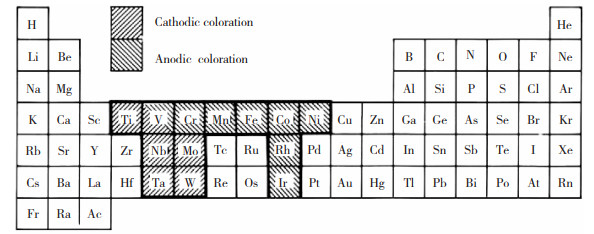
|
图 3 元素周期表(镧系和锕系元素除外),不同阴影表示不同电致变色性质[14] Fig.3 Periodic system of elements (except lanthanides and actinides), where different shaded boxes signify different electrochromic properties[14] |
| $ {\rm WO}_{3}({\rm bleached})+x{\rm Li}^{+} +x{\rm e}^{-} ↔ {\rm Li}_{x}{\rm WO}_{3}({\rm colored}). $ | (1) |
离子存储层主要用来存储变色过程中所需要的离子和电子与电致变色层相匹配,通常具有较高的离子存储容量和透过率。离子存储层可以是在离子嵌入脱出过程中几乎不发生颜色变化的材料,如二氧化钛(TiO2)和氧化钨镍(NiWOx)等,只承担存储离子和电子的作用;也可以是具有与电致变色层相反性能的阳极电致变色材料,在对其施加负电压时,离子和电子注入为褪色过程,而施加正电压时,离子和电子脱出时着色,这种材料与电致变色层同时着色或褪色,具有协同效应,又称互补变色层。最常用的互补变色层为氧化镍(NiO),NiO在锂离子电解质中变色原理较为复杂,一般分为两步,初始制备的NiO通常呈现深灰色,Li+注入NiO中后形成透明的LiyNiO,这一步是不可逆的;随后Li+与电子在LiyNiO中脱出与嵌入,薄膜在灰褐色和透明态之间可逆转换,如式(2)和(3)所示[15]。由于氧化镍在褪色态的透过率较低,透过率调制范围较小,容量较小,因此,对NiO层进行掺杂以提高其电致变色性能也是研究热点之一。如Wang等[16]采用磁控溅射的方法制备了Li掺杂NiO(LiNiOx)和Li、铝(Al)共掺杂NiO(Al-LiNiOMx)薄膜,与纯NiO相比,Al-LiNiOx薄膜的透过率调制范围和容量均有提升。
| $ {\rm NiO(as-deposited)} + y{\rm Li}^{+} + y{\rm e}^{-} →\\ \;\;\;{\rm Li}_{y}{\rm NiO(bleached)},$ | (2) |
| $ {\rm Li}_{y}{\rm NiO(bleached)} ↔ {\rm Li}_{y-z}{\rm NiO (colored)}+ \\ \;\;\;z{\rm Li}^{+}+z{\rm e}^{-}. $ | (3) |
电解质层位于电致变色层和离子存储层之间,主要承担传导离子和阻隔电子的作用,因此,需要具有一定的厚度、高的离子传导率、低的电子传导率和高透过性。常用的固态电解质有两种,一种是含锂的无机盐如钽酸锂(LiTaO3)、铌酸锂(LiNbO3)和掺氮磷酸锂(LiPON)等,既能传导离子又可提供电解质离子;另一种为不含锂的金属氧化物,如氧化钽(Ta2O5)、二氧化硅(SiO2)和二氧化锆(ZrO2)等,只有传导和阻隔的作用,需要额外引入电解质离子,又可称为离子传导层。
1.4 透明导电层透明导电层通常要求具有较高的透过率和较低的电阻,目前常用的有氧化铟锡(ITO)和掺氟氧化锡(FTO),由于其成本较高且柔性较差,银纳米线(AgNW)被认为可代替ITO电极,但容易氧化的特点限制了其进一步应用[17]。
2 全固态电致变色器件研究进展全固态电致变色器件通常采用蒸发镀膜或磁控溅射的方法制备。蒸发镀膜原理是在高真空下,加热材料使其熔化蒸发,气相蒸发材料在基底上冷却沉积成薄膜。加热源主要有电阻和电子束加热两种。电阻加热通常采用钨、钼等熔点较高的金属作为蒸发舟,通过电加热蒸发舟使材料熔化蒸发,而电子束加热是通过对钨灯丝施加几千伏高压激发出高能电子,在磁场作用下电子束打在蒸发材料上,动能转化为热能而使材料熔化蒸发。蒸发镀膜是一种快速的镀膜方式,但由于蒸发材料携带的能量较低,沉积形成的膜层结合力较弱,需要良好的条件控制。磁控溅射是另一种常见的全固态电致变色器件制备方法,其原理是电子与氩原子碰撞使其电离,离子在电场中高速飞向靶材,溅射出靶材原子或分子,在基底上沉积成膜,磁场将电子约束在一定的区域内,增加电离离子数量,从而大幅增加溅射效率。磁控溅射过程中,溅射出来的靶材原子具有很高的能量,因此,沉积在基底时具有很好的结合力。
无论采用哪种制备方法,其基本的器件结构是一致的,都是在单一基底上逐层沉积各层薄膜,最终形成电致变色器件。根据电解质层的不同,本文将从含锂盐电解质和离子传导层两种器件来简述全固态电致变色器件的研究进展。
2.1 含锂盐电解质的器件电致变色器件是通过离子和电子在电致变色层的嵌入实现变色的,因此,电解质离子是必不可少的,含锂盐电解质层的全固态电致变色器件在制备电解质层时即可引入电解质离子,表 1总结了2000年以来这种类型的全固态电致变色器件结构与性能[9-10, 15-16, 18-34]。
| 表 1 已报道的含锂盐电解质全固态电致变色器件列表[9-10, 15-16, 18-34] Table 1 Previously reported all-solid-state inorganic ECDs with lithium salts electrolyte[9-10, 15-16, 18-34] |
经典的全固态电致变色器件为5层结构,包括两层透明导电层ITO,电致变色层WO3,电解质层如LiNbO3、LiBSO和LiTaO3等,离子存储层通常为NiO。早在2000年,Zhang等[18]以LiNbO3为电解质层,采用反应磁控溅射的方法制备了全固态电致变色器件,着色态和褪色态透过率分别为8%和72%,器件同时具有良好的记忆效应,在24 h后,光密度变化非常小,但器件的循环性能有待提高,在经过2 000圈循环后透过率变化范围仅有不到10%。而后Song等[21]制备了以LiTaO3为电解质的全固态电致变色器件,并研究了不同氧分压下制备的NiO器件的变色性能,氧浓度(体积分数)为6%的器件具有最佳光学调制范围,在可见波段最大达到67%(±5V下),着色时间85 s,褪色时间42 s,如图 4所示。Liu等[22]使用相同的器件结构,在聚对苯二甲酸乙二醇酯(PET)柔性ITO衬底上制备了全固态电致变色器件,在810 nm波长处透过率调制范围达到了75.4%(±4 V下),器件褪色时间较慢,为55 s,着色速度非常快,仅为7 s,着色效率为68.5 cm2/C。

|
图 4 不同条件全固态电致变色器件的透过率(a)和氧浓度为6%的器件在550 nm处的时序图(b)[21] Fig.4 Variation of Tave with different O2 concentrations (a) and transmittance of ECD in 6% O2 concentration at a wavelength of 550 nm (b)[21] |
LiPON是电池中常用的离子导体,Oukassi等[30]通过磁控溅射的方法在ITO玻璃基底上制备了LiPON薄膜,研究表明,该薄膜在400~2 000 nm波长范围内透过率高于85%,离子电导率为2.7×10-6S/cm,符合电解质层的基本要求,将其应用于全固态电致变色器件,在波长600 nm处透过率变化范围最大可达40%(±1.5 V下)。
Atak等[25, 31-32]采用磁控溅射的方法,以LiNbO3为电解质,Ta2O5为离子传导层制备了结构为ITO/NiO/Ta2O5/LiNbO3/WO3/ITO的全固态器件,并开展了一系列研究,该器件在波长550 nm处可实现34%的透过率变化(±2 V下), Atak等认为即使没有对器件施加电压,离子导体层或电致变色层中也应该包含离子,因此,其在上述器件中引入湿锂化过程,即将ITO/WO3/LiNbO3/Ta2O5薄膜浸入0.01 M的LiClO4/PC溶液中,对其施加2.5 V电压,使锂离子注入Ta2O5中,清洗干净后制备剩余膜层,如图 5所示。研究结果表明,增加湿锂化过程后,器件透过率变化范围明显增大,在波长550 nm透过率调制范围为71.7%(±4 V下)。ZrO2具有高离子电导率和低电子电导率,在近红外到中远红外吸收较低,也是常用的离子导体,因此,Atak使用ZrO2代替Ta2O5作为离子传导层,同样引入湿锂化过程,这种结构的器件透过率变化范围可以达到53%(±3 V,550 nm)。
电解质层可能存在缺陷且电子电导率相对较高,不能有效限制电子的转移,因此,5层结构的电致变色器件通常存在比较大的漏电流,当器件着色完成断开电压后会很快自褪色,记忆效应比较差,增加能耗。Huang等[24]在传统电致变色器件的基础上设计了7层结构的电致变色器件,即在电解质层两侧增加电子阻挡层Si3N4,与5层结构的电致变色器件对比,增加Si3N4层后漏电流从216.0 μA/cm2减小到32.1 μA/cm2;器件的记忆效应也明显增强,着色至25%断开电压,无Si3N4层的器件很快自褪色,而有Si3N4层的4 000 s后仅透过率增加20%,如图 6所示。Liu等[27]使用Ta2O5作为电子阻挡层同样取得良好的改善记忆效应的效果。

|
图 6 电致变色器件的计时电流曲线(a)和开路状态下记忆效应(b)[24] Fig.6 Step chronoamperometric curves (a) and open circuit memory test (b) of ECD[24] |
全固态器件中最常用的电解质层LiNbO3和LiTaO3通常使用陶瓷靶材进行溅射,而溅射陶瓷靶材只能用射频电源,效率相对比较低,且Nb和Ta元素相对稀少,针对此问题,Xie等[34]使用锂-铝合金靶,采用直流溅射的方法制备了LixAlOz用于全固态电致变色器件,透过率变化范围在波长670 nm处可以达到74.4%(±3 V下),循环10 000次后衰减幅度很小,低于10%,同时具有很快的响应速度。
2.2 含离子传导层的器件表 2总结了2000年以来含离子传导层的全固态电致变色器件结构及性能。对于离子传导层结构的器件,通常需要额外引入电解质离子,引入方法有很多,第1种是在制备某些膜层后,将其浸入到含有H+或者Li+电解质溶液中,施加一定的电压,电解质离子在电势能的作用下注入到薄膜中,而后再制备其他膜层。例如, Wang等[4]采用直流反应磁控溅射方法,在ITO玻璃基底上制备了ITO/WO3/Ta2O5层,然后浸入LiClO4/PC溶液中,对其施加1.5 V的电压注入Li+,清洗干净后,再依次制备NiO和顶电极ITO,该器件最大透过率变化范围为66.5%(±4 V下)。
| 表 2 已报道的离子传导层全固态电致变色器件列表[35-54] Table 2 Previously reported all-solid-state inorganic ECDs with ion conducting layer[35-54] |
第2种离子引入方法是在镀膜过程中引入电解质离子,在镀膜过程中,加入H2作为反应气体,使膜层中含有H+,如Dong等[47]在ITO玻璃上制备NiO时引入H2,制备NiOx: H薄膜,使用H+作为电解质离子,随后再制备ZrO2、WO3和顶电极ITO构成全固态器件,器件在550 nm处最大变化范围达到68%(±4 V下),如图 7所示。随后,Dong等[48]又使用Ta2O5为离子传导层,在制备Ta2O5时引入H2,器件在550 nm处变化范围达到60%(±2 V下)。
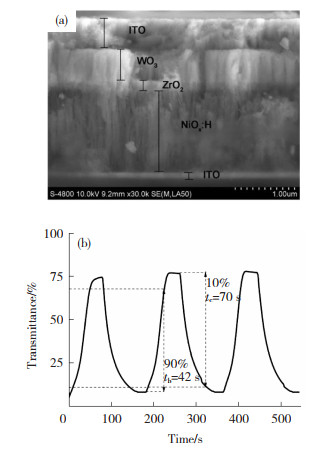
|
图 7 电致变色器件截面图(a)及响应时间曲线(b)[47] Fig.7 SEM cross-section image (a) and response time curves (b) of multilayer ECD[47] |
第3种引入离子的方法是器件制备完成后,放在相对湿润的环境中使水分子进入器件中。如Niwa等[42]以Ta2O5为离子传导层,制备了结构为Al/WO3/Ta2O5/IrxSn1-xO2/ITO的全固态器件,制备完成后在室温和相对湿度60%的环境下放置15 h,随后用环氧树脂封装,器件中的电解质实质上为H2O,施加电压时,器件中的H2O电离出H+和OH-,在电场的作用下与两个电致变色层发生反应而使器件整体变色,该器件的反射率可从60%变至15%,如图 8所示。Pan等[54]在钠钙玻璃基底上制备了ITO/NiOx/Ta2O5/WO3/ITO结构的全固态器件,多孔薄膜吸收水分子为电解质,在600 nm处透过率变化可以达到70.9%,着色13 s,褪色仅2 s。
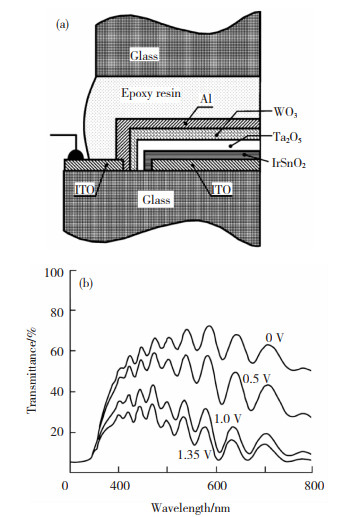
|
图 8 全固态器件结构(a)及反射率光谱(b)[42] Fig.8 Structure (a) and reflectance spectra (b) of all-solid- state ECD[42] |
除经典结构的全固态电致变色器件外,也有少量有关其他结构的器件报道,如Mitsugi等[55]使用脉冲激光沉积的方法在石英玻璃基底上制备了ITO/LiyWO3-x/Li1-zMn2O4/ITO结构的器件,Li1-zMn2O4既是电解质层也是离子存储层,该器件在波长750 nm处透过率在50%到80%之间变化, 而450 nm处透过率几乎不变化(±5 V下)。Li等[56]采用电子束和电阻蒸发法在ITO玻璃基底上制备了不含离子传导层的4层结构器件ITO/Li-NiO/Li-WO3/ITO,该器件具有良好的循环稳定性,在循环1 000次后透过率变化范围为32%(±2.5 V下)。
3 展望电致变色技术是一种应用前景广阔的技术,全固态是器件应用的必然趋势。虽然目前已开发出多种材料与结构的全固态电致变色器件,但也应该看到目前全固态电致变色器件性能的局限性,如透过率调控幅度大的器件响应速度较慢,而响应速度较快的器件调控幅度又比较小。这两个关键性能指标难以实现兼容,限制了这项技术的进一步应用。同时,目前绝大部分全固态电致变色器件仅能实现透光和不透光的切换,颜色单调,无法实现更多的颜色改变,这也是目前全固态电致变色器件存在的一个主要问题。通过对离子存储,如NiO、V2O5等的掺杂,可有效改善器件的调控能力、响应速度和颜色等关键指标,是未来全固态电致变色器件研究的主要发展方向。
| [1] |
DEB S. A novel electrophotographicsystem[J]. Applied Optics, 1969, 8(101): 192-195. DOI:10.1364/AO.8.S1.000192 |
| [2] |
LAMPERT C. Electrochromic materials and devices for energy efficient windows[J]. Solar Energy Materials, 1984, 11: 1-27. DOI:10.1016/0165-1633(84)90024-8 |
| [3] |
SVENSSON J, GRANQVIST C. Electrochromic coatings for "smart windows"[J]. Solar Energy Materials, 1985, 12(6): 391-402. DOI:10.1016/0165-1633(85)90033-4 |
| [4] |
GREER B. Control system for electrochromic devices: U.S. Patent 7277215[P]. 2007-10-02.
|
| [5] |
WANG Z, PRADHAN A, ROZBICKI R. Electrochromic devices: U.S. Patent 8764951[P]. 2014-07-01.
|
| [6] |
许倩斐, 李军, 赵军.一种电致变色玻璃:CN 204595399U[P].2015-08-26.
|
| [7] |
董子尧, 李昕. 电致变色材料, 器件及应用研究进展[J]. 材料导报, 2012, 26(13): 50-57. DONG Ziyao, LI Xin. Research progress in electrochromic materials, devices and applications[J]. Materials Review, 2012, 26(13): 50-57. DOI:10.3969/j.issn.1005-023X.2012.13.011 |
| [8] |
ZHOU Ding, XIE Dong, XIA Xinhui, et al. All-solid-state electrochromic devices based on WO3‖ NiO films: material developments and future applications[J]. Science China Chemistry, 2017, 60(1): 3-12. DOI:10.1007/s11426-016-0279-3 |
| [9] |
XIAO Yu, DONG Guobo, HUANG Qingjiao, et al. Electro-optical performance of inorganic monolithic electrochromic device with a pulsed DC sputtered LixMgyN ion conductor[J]. Journal of Solid State Electrochemistry, 2018, 22(1): 275-283. DOI:10.1007/s10008-017-3742-9 |
| [10] |
XIAO Yu, ZHONG Xiaolan, GUO Junji, et al. The role of interface between LiPON solid electrolyte and electrode in inorganic monolithic electrochromic devices[J]. ElectrochimicaActa, 2018, 260: 254-263. DOI:10.1016/j.electacta.2017.12.020 |
| [11] |
AZAM A, KIM J, PARK J, et al. Two-dimensional WO3 nanosheetschemically converted from layered WS2 for high-performance electrochromic devices[J]. Nano Letters, 2018, 18(9): 5646-5651. DOI:10.1021/acs.nanolett.8b02150 |
| [12] |
ZHANG Jun, TU Jiangping, XIA Xinhui, et al. Hydrothermally synthesized WO3 nanowire arrays with highly improved electrochromic performance[J]. Journal of Materials Chemistry, 2011, 21(14): 5492-5498. DOI:10.1039/c0jm04361c |
| [13] |
GIANNUZZI R, BALANDEH M, MEZZETTI A, et al. On the Li intercalation kinetics in tree-like WO3, electrodes and their implementation in fast switchable electrochromic devices[J]. Advanced Optical Materials, 2015, 3(11): 1614-1622. DOI:10.1002/adom.201500152 |
| [14] |
GRANQVIST C G. Electrochromics for smart windows: Oxide-based thin films and devices[J]. Thin Solid Films, 2014, 564(1): 1-38. DOI:10.1016/j.tsf.2014.02.002 |
| [15] |
ZHU Ying, XIE Lingling, CHANG Tianci, et al. High performance all-solid-state electrochromic device based on LixNiOy layer with gradient Li distribution[J]. ElectrochimicaActa, 2019, 317: 10-16. DOI:10.1016/j.electacta.2019.05.12 |
| [16] |
WANG Caiping, DONG Guobo, ZHAO Yuyang, et al. Enhanced electrochromic performance on anodic nickel oxide inorganic device via lithium and aluminum co-doping[J]. Journal of Alloys and Compounds, 2020, 821: 153365. DOI:10.1016/j.jallcom.2019.153365 |
| [17] |
YAN Chaoyi, KANG Wenbin, WANG Jiangxin, et al. Stretchable and wearable electrochromic devices[J]. ACS Nano, 2014, 8(1): 316-322. DOI:10.1021/nn404061g |
| [18] |
ZHANG Xuping, ZHANG Haokang, LI Qing, et al. An all-solid-state inorganic electrochromic display of WO3 and NiO films with LiNbO3 ion conductor[J]. IEEE Electron Device Letters, 2000, 21(5): 215-217. DOI:10.1109/55.841300 |
| [19] |
YANG Haigang, WANG Cong, ZHU Kaigui, et al. An all-thin-film electrochromic device composed of MoO3-LiBSO-NiOx, multilayer structure[J]. Chinese Physics Letters, 2008, 25(2): 740-742. DOI:10.1088/0256-307X/25/2/105 |
| [20] |
YANG Haigang, WANG Cong, DIAO Xungang, et al. A new all-thin-film electrochromic device using LiBSO as the ion conducting layer[J]. Journal of Physics D: Applied Physics, 2008, 41(11): 115301. DOI:10.1088/0022-3727/41/11/115301 |
| [21] |
SONG Xingwang, DONG Guobo, GAO Fangyuan, et al. Properties of NiOx and its influence upon all-thin-film ITO/NiOx/LiTaO3/WO3/ITO electrochromic devices prepared by magnetron sputtering[J]. Vacuum, 2015, 111: 48-54. DOI:10.1016/j.vacuum.2014.09.007 |
| [22] |
LIU Qirong, DONG Guobo, XIAO Yu, et al. An all-thin-film inorganic electrochromic device monolithically fabricated on flexible PET/ITO substrate by magnetron sputtering[J]. Materials Letters, 2015, 142: 232-234. DOI:10.1016/j.matlet.2014.11.151 |
| [23] |
OUKASSI S, GIROUD-GARAMPON C, DUBARRY C, et al. All inorganic thin film electrochromic device using LiPON as the ion conductor[J]. Solar Energy Materials and Solar Cells, 2016, 145: 2-7. DOI:10.1016/j.solmat.2015.06.052 |
| [24] |
HUANG Qingjiao, DONG Guobo, XIAO Yu, et al. Electrochemical studies of silicon nitride electron blocking layer for all-solid-state inorganic electrochromic device[J]. Electrochimica Acta, 2017, 252: 331-337. DOI:10.1016/j.electacta.2017.08.177 |
| [25] |
ATAK G, COȘKUN Ö. Annealing effects of NiO thin films for all-solid-state electrochromic devices[J]. Solid State Ionics, 2017, 305: 43-51. DOI:10.1016/j.ssi.2017.05.002 |
| [26] |
DONG Dongmei, WANG Wenwen, ROUGIER A, et al. Life-cycling and uncovering cation-trapping evidence of monolithic inorganic electrochromic device: glass/ITO/WO3/LiTaO3/NiO/ITO[J]. Nanoscale, 2018, 10(35): 16521-16530. DOI:10.1039/c8nr02267d |
| [27] |
LIU Qirong, DONG Guobo, CHEN Qianqian, et al. Charge-transfer kinetics and cyclic properties of inorganic all-solid-state electrochromic device with remarkably improved optical memory[J]. Solar Energy Materials and Solar Cells, 2018, 174: 545-553. DOI:10.1016/j.solmat.2017.09.012 |
| [28] |
LIU Qirong, CHEN Qianqian, ZHANG Qianqian, et al. Dynamic behaviors of inorganic all-solid-state electrochromic device: role of potential[J]. Electrochimica Acta, 2018, 269: 617-623. DOI:10.1016/j.electacta.2018.02.050 |
| [29] |
XIAO Yu, DONG Guobo, GUO Junji, et al. Thickness dependent surface roughness of sputtered Li2.5TaOx ion conductor and its effect on electro-optical performance of inorganic monolithic electrochromic device[J]. Solar Energy Materials and Solar Cells, 2018, 179: 319-327. DOI:10.1016/j.solmat.2017.12.027 |
| [30] |
ATAK G, COȘKUN Ö. LiNbO3 thin films for all-solid-state electrochromic devices[J]. Optical Materials, 2018, 82: 160-167. DOI:10.1016/j.optmat.2018.05.062 |
| [31] |
ATAK G, COȘKUN Ö. Fabrication of an all solid-state electrochromic device using zirconium dioxide as an ion-conducting layer[J]. Thin Solid Films, 2018, 664: 70-78. DOI:10.1016/j.tsf.2018.08.030 |
| [32] |
COȘKUN Ö, ATAK G. The effects of lithiation process on the performance of all-solid-state electrochromic devices[J]. Thin Solid Films, 2018, 662: 13-20. DOI:10.1016/j.tsf.2018.07.019 |
| [33] |
LIU Lei, DU Kai, HE Zhibing, et al. High-temperature adaptive and robust ultra-thin inorganic all-solid-state smart electrochromic energy storage devices[J]. Nano Energy, 2019, 62: 46-54. DOI:10.1016/j.nanoen.2019.04.079 |
| [34] |
XIE Linging, ZHAO Shuwen, ZHU Ying, et al. High performance and excellent stability of all-solid-state electrochromic devices based on a Li1.85AlOz ion conducting layer[J]. ACS Sustainable Chemistry & Engineering, 2019, 7(20): 17390-17396. DOI:10.1021/acssuschemeng.9b04501 |
| [35] |
LARSSON A L, NIKLASSON G A. Optical properties of electrochromic all-solid-state devices[J]. Solar Energy Materials and Solar Cells, 2004, 84(1): 351-360. DOI:10.1016/j.solmat.2004.02.051 |
| [36] |
YOSHIMURA H, KOSHIDA N. Fast electrochromic effect obtained from solid-state inorganic thin-film configuration with a carrier accumulation structure[J]. Applied Physics Letters, 2006, 88(9): 093509. DOI:10.1063/1.2167798 |
| [37] |
SUBRAHMANYAM A, KUMAR C S, KARUPPASAMY K M. A note on fast protonic solid state electrochromic device: NiOx/Ta2O5/WO3-x[J]. Solar Energy Materials and Solar Cells, 2007, 91(1): 62-66. DOI:10.1016/j.solmat.2006.07.003 |
| [38] |
TAJIMA K, YAMADA Y, BAO S, et al. Aluminum buffer layer for high durability of all-solid-state switchable mirror based on magnesium-nickel thin film[J]. Applied Physics Letters, 2007, 91(5): 051908. DOI:10.1063/1.2761842 |
| [39] |
TAJIMA K, YAMADA Y, BAO S, et al. All-solid-state switchable mirror on flexible sheet[J]. Surface and Coatings Technology, 2008, 202(22): 5633-5636. DOI:10.1016/j.surfcoat.2008.06.098 |
| [40] |
TAJIMA K, YAMADA Y, BAO S, et al. Near colorless all-solid-state switchable mirror based on magnesium-titanium thin film[J]. Journal of Applied Physics, 2008, 103(1): 013512. DOI:10.1063/1.2829816 |
| [41] |
LI Zhuying, YE Liu, ZHANG Mingliang, et al. Optical and electrochemical properties of the protonic state electrochromic device: NiOx/Ta2O5/WO3-x[C]// Proceedings of 4th International Symposium on Advanced Optical Manufacturing and Testing Technologies: Advanced Optical Manufacturing Technologies.[S.l.]: International Society for Optics and Photonics, 2009.
|
| [42] |
NIWA T, TAKAI O. All-solid-state reflectance-type electrochromic devices using iridium tin oxide film as counter electrode[J]. Thin Solid Films, 2010, 518(18): 5340-5344. DOI:10.1016/j.tsf.2010.04.030 |
| [43] |
NIWA T, TAKAI O. Optical and electrochemical properties of all-solid-state transmittance-type electrochromic devices[J]. Thin Solid Films, 2010, 518(6): 1722-1727. DOI:10.1016/j.tsf.2009.11.062 |
| [44] |
WANG Shengchang, LIU Kuangyi, HUANG J L. Tantalum oxide film prepared by reactive magnetron sputtering deposition for all-solid-state electrochromic device[J]. Thin Solid Films, 2011, 520(5): 1454-1459. DOI:10.1016/j.tsf.2011.08.046 |
| [45] |
JAING C C, TANG C J, CHAN C C, et al. Optical constants of electrochromic films and contrast ratio of reflective electrochromic devices[J]. Applied Optics, 2014, 53(4): A154-A158. DOI:10.1364/AO.53.00A154 |
| [46] |
PATEL K J, DESAI M S, PANCHAL C J. Studies of ZrO2 electrolyte thin-film thickness on the all-solid thin-film electrochromic devices[J]. Journal of Solid State Electrochemistry, 2015, 19(1): 275-279. DOI:10.1007/s10008-014-2600-2 |
| [47] |
DONG Dongmei, WANG Wenwen, DONG Guobo, et al. Electrochromic properties of NiOx: H films deposited by DC magnetron sputtering for ITO/NiOx: H/ZrO2/WO3/ITO device[J]. Applied Surface Science, 2015, 357: 799-805. DOI:10.1016/j.apsusc.2015.09.056 |
| [48] |
DONG Dongmei, WANG Wenwen, DONG Guobo, et al. Electrochromic properties and performance of NiOx films and their corresponding all-thin-film flexible devices preparedby reactive DC magnetron sputtering[J]. Applied Surface Science, 2016, 383: 49-56. DOI:10.1016/j.apsusc.2016.04.154 |
| [49] |
WANG M C, HSIEH M H, CHEN Y C, et al. All-solid-state electrochromic device integrated with near-IR blocking layer for image sensor and energy-saving glass application[J]. Applied Physics Letters, 2016, 109(12): 123501. DOI:10.1063/1.4962842 |
| [50] |
CHE Xiaoqi, WU Zhonghou, DONG Gubo, et al. Properties of all-thin-film glass/ITO/WO3: H/Ta2O5/NiOx/ITO electrochromic devices prepared by magnetron sputtering[J]. Thin Solid Films, 2018, 662: 6-12. DOI:10.1016/j.tsf.2018.07.005 |
| [51] |
DONG Dongmei, WANG Wenwen, BARNABÉ A, et al. Enhanced electrochromism in short wavelengths for NiO:(Li, Mg) films in full inorganic device ITO/NiO:(Li, Mg)/Ta2O5/WO3/ITO[J]. ElectrochimicaActa, 2018, 263: 277-285. DOI:10.1016/j.electacta.2018.01.049 |
| [52] |
ATAK G, COȘKUN Ö D. Effects of anodic layer thickness on overall performance of all-solid-state electrochromic device[J]. Solid State Ionics, 2019, 341: 115045. DOI:10.1016/j.ssi.2019.115045 |
| [53] |
LEE S J, CHOI D S, KANG S H, et al. VO2/WO3-based hybrid smart windows with thermochromic and electrochromic properties[J]. ACS Sustainable Chemistry & Engineering, 2019, 7(7): 7111-7117. DOI:10.1021/acssuschemeng.9b00052 |
| [54] |
PAN Lijun, HAN Qiaonan, DONG Zhongliang, et al. Reactively sputtered WO3 thin films for the application in all thin film electrochromic devices[J]. Electrochimica Acta, 2019, 328: 135107. DOI:10.1016/j.electacta.2019.135107 |
| [55] |
MITSUGI F, NAKAMURA A, KODAMA Y, et al. Preparation of inorganic solid state thin film for electrochromic application[J]. Thin Solid Films, 2007, 515(9): 4159-4165. DOI:10.1016/j.tsf.2006.02.072 |
| [56] |
LI Wenjie, ZHANG Xiang, CHEN Xi, et al. Preparation and performance of fast-response ITO/Li-NiO/Li-WO3/ITO all-solid-state electrochromic devices by evaporation method[J]. Materials Letters, 2020, 127464. DOI:10.1016/j.matlet.2020.127464 |
 2020, Vol. 28
2020, Vol. 28



